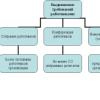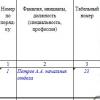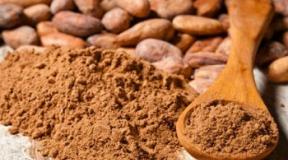A test to determine your metabolic type. Three types of metabolism - how to lose weight and how to get rid of acne knowing your type Metabolic types according to the Kelly test
Doctors came to the conclusion that we are all divided into four main groups - depending on what kind of activity prevails in the body. The test will help you find out your type of metabolism. It will be especially useful for those who want to get rid of extra pounds, but find it difficult to choose the right diet and exercise.
Depending on which of the endocrine glands in the body is dominant, people can be divided into four types: adrenal, ovariotomic (gonads), thyroid, pituitary.
Each of them needs a special diet and exercise to stay physically and mentally awake.
For example, the adrenal type is gaining weight in the upper torso and needs to be calorie restricted. On the other hand, the pituitary type has difficulty increasing muscle mass and needs proteins and starchy vegetables. Some types do not lose weight on low-fat diets because not everyone metabolizes food the same way.
Each type prefers a certain food, which leads to increased stimulation of the dominant gland and leads to imbalances in metabolism. What type are you? To find out, answer the following questions:
1. What characterizes your body shape best?
A. Long, with prominent bone contours
B. Strong, steady, sturdy
C. Pear shape with a smaller upper body
D. Small body (almost baby)
2. What characterizes your skeleton best?
A. Long arms and legs, oval head
B. Medium-length limbs, square toes, oval or rectangular head
C. Small or prominently bony upper body, translucent ribs, thick legs, heart-shaped head
D. Small bones, delicate arms, large eyes and / or head
3. What characteristics best suit your personality?
A. Full of energy, enthusiasm, adaptable
B. Self-confident, calm, organized
C. Open, sociable, educative
D. Discreet, secretive, intelligent
4. What characterizes your energy level best?
A. Unstable energy throughout the day
B. Stable energy throughout the day
C. More energy in the afternoon or evening
D. More energy in the morning
5. Where do you gain the most weight?
A. Below the navel, upper thighs, around the mid-torso
B. Abdomen, back, arms, upper torso
C. Buttocks, legs
D. Evenly throughout the body
6. Your favorite food to spread on bread:
A. Honey, jam
B. Nut butter, cheese
C. Garlic oil
D. Fruit puree or processed cheese.
7. Your favorite pasta sauce:
A. Red sauce, butter
B. White sauce, butter
C. With spices
D. Butter or cheese sauces
8. Your Favorite Snack Food:
A. Cookies, muffins, cakes, caffeinated lemonade
B. Cheese, popcorn, nuts
C. Chips, chocolate
D. Fruit, cheese, sorbet
Outcomes
Count which points (A, B, C, D) are more. If you scored a close number of points from two groups, then you combine the characteristics of two groups at once.
If more than A - thyroid type
If more than B - adrenal type
If more than C - ovariotomic type
If more than D - pituitary type
Thyroid type(the dominant gland is the thyroid gland)
Diet. This type tends to eat sweets to maintain energy levels. You should avoid sweets, white flour, fruit juices, and caffeine. To keep energy levels stable and avoid snacking cravings, increase the amount of protein and complex carbohydrates in your diet. You need to eat small meals every four hours.
What to eat daily? Lean proteins, including egg whites, poultry, fish, tofu (180-240g);
Above ground vegetables such as pumpkin, mushrooms, peppers (3-4 cups),
Starchy vegetables and legumes (1-2 cups)
Monounsaturated fats such as olives, avocados, nuts (4-5 tablespoons)
Low-fat dairy products (2-3 cups)
Eat in moderation. Porridge, bread (1-2 servings), fruits (1-2 pieces)
If you want to have a snack. Eat protein such as protein chocolates or nuts, but watch the portions as you eat. they have a lot of fat.
Workout. Everyone must exercise and. It is necessary to strengthen bones and convert fat mass into muscle, as well as improve blood circulation. It is best to practice brisk walking, ice skating, dancing, especially ballet, rhythmic gymnastics, horse riding. Swim with butterfly, breaststroke and backstroke styles. Good Chinese gymnastics tai chi and qigong, as well as a variety of martial arts.
Adrenal type(the dominant gland is the adrenal glands)
Diet. Light breakfast, light or medium lunch, big dinner. You should avoid saturated fat, alcohol, salt, and meat.
What to eat daily ? Above ground vegetables: Greens, pumpkin, tomatoes, mushrooms, peppers (5-6 cups)
Starchy vegetables and legumes (2 cups)
Fruit (3-4 pieces)
Low-fat dairy products (3 servings: 1 serving = 1 cup of yogurt or milk)
Porridge and bread (3 servings)
Eat in moderation. Poultry and fish (120-150 g), monounsaturated fats such as olives, avocados, nuts (3-4 tablespoons);
Pastries and sweets (no more than 2 servings: one serving = one crumpet or two medium biscuits),
If you want to have a snack. Eat low-fat dairy (yogurt), vegetables and fruits
 Workout.
The best exercise for this type is cycling, followed by walking, skiing. Belly dance and indoor trampoline jumping - mini trampoline can work wonders in helping to carve a beautifully shaped body.
Workout.
The best exercise for this type is cycling, followed by walking, skiing. Belly dance and indoor trampoline jumping - mini trampoline can work wonders in helping to carve a beautifully shaped body.
Ovariotomic (Pear-shaped) type(dominant gland - ovaries, testes)
Diet. Its purpose is to protect you from oily and spicy foods, especially red meat and white flour products. Diet distribution - light breakfast, moderate lunch, moderate dinner.
What to eat daily? Above ground vegetables such as green vegetables, pumpkin, tomatoes, mushrooms, peppers (4-5 cups), Starchy vegetables and legumes (3 cups);
Fruit (6-7 pieces)
Low-fat dairy products (3-5 servings: 1 serving = 1 cup of yogurt or milk, 50g low-fat cheese)
Poultry or fish (120-150g)
Eat in moderation... Porridge, bread (2-3 servings), monounsaturated fats such as olives, avocados, nuts (2-3 tbsp);
If you want to have a snack. High water content vegetables and fruits such as watermelon, vegetable juices
Workout. Useful jumping rope, stationary cycling, very fast walking, slow running, ski simulator, all exercises that are performed while kneeling, lifting small weights with each leg in turn.
For men, exercises for the upper body with a two-kilogram barbell are useful: pushing up and down, bringing the bar back behind the head, twisting it in a circle in each hand. Sitting and lying down, perform "scissors" with your feet, up and down and left and right, rotation around its axis, roller skating and skiing.
 Pituitary type
Pituitary type
Diet. This diet is high in protein, starchy vegetables. Hearty breakfast, average lunch, modest dinner. You should avoid dairy, caffeine, and white flour.
What to eat daily? Meat or poultry (240-300g)
Vegetables not ripening in the ground such as green vegetables, pumpkin, tomatoes, mushrooms, peppers (3-4 cups), Starchy vegetables and legumes (3-4 cups);
Eat in moderation... Porridge, bread (2-3 servings), fruits (2-3 pieces), monounsaturated fats such as olives, avocados, nuts (2-3 tbsp);
If you want to have a snack. Eat protein, protein chocolates
Workout. Belly dance is useful for both women and men. Remember to do relaxation exercises, including walking in water and light swimming (preferably on your back). They are also shown any movement in the air - from walking to light running. Classes associated with weights, a large load on the shells are clearly contraindicated. These exercises will increase the imbalance.
Lokatskaya Liliana
How to determine your metabolic type?
The foundations of this metabolic theory were created in the 1960s by dentist William Kelley. According to him, metabolic processes correlate with the reactions of the sympathetic (fight) and parasympathetic (flight) nervous systems of the body. Kelly found that respondents react to danger in different ways, depending on the predominance of the first or second type of nervous system in them. In the sympathetic version, they begin to fight stress, in the parasympathetic version, they flee from it. The predominance of one of these reactions determines metabolic type person.Kelly's work was continued by nutritional consultant William Wolcott. He created a questionnaire with which you can install metabolic type any person. Since food preferences also depend on it, having determined the type, it is possible to advise, and thereby ensure weight loss, as well as save a person from certain diseases. However, it is necessary to clarify - not all doctors trust metabolic therapy, considering its provisions unproven.
There are three types of metabolism:
Protein (or protein) type:
This type is characteristic of persons with a parasympathetic dominant (flight). Such people are often nervous and absent-minded, they seem energetic, but internally exhausted. They are haunted by constant hunger, they love fatty, salty, heavy foods and are practically unable to sustain a low-calorie diet. The best choice for this type of person is protein. They should include meats, especially those rich in purine, in their diet, as well as other organic foods such as organ meats. Vegetarians should also choose protein-based foods such as soy, tofu, legumes (especially lentils), cheeses and dairy products, quinoa, nuts, and tempei (an Indonesian food made from fermented soybeans). For the protein type, vegetable oils and animal fats are also shown, but the healthiest of them should be preferred.Carbohydrate type
People with a sympathetic dominant (wrestling) most often belong to the carbohydrate type of metabolism. They are addicted to caffeine and are very fond of sweets. Due to low appetite, they rarely experience problems with being overweight, and they struggle with it only because they are perfectionists and are always trying to achieve more. The diet for people with a carbohydrate type is directly opposite to the protein type of metabolism - these are raw or slightly steamed vegetables, raw and frozen fruits and vegetables, seeds and nuts, whole grains. Consumption of proteins, especially those with a high purine content, as well as animal fats and vegetable oils, should be minimized.Mixed type
The situation is best in people with a mixed metabolic type, in whom the sympathetic system is in equilibrium with the parasympathetic system. They have a normal appetite, they do not abuse salt or sugar. People of mixed type have only one problem: they are prone to fatigue, anxiety and nervousness, although it cannot be said that this tendency is higher for them than for people with other types of metabolism. For people with this type of metabolism, it is best to stick to a certain proportion when consuming proteins and carbohydrates.In order to keep your body running, you need specific fuel to supply every cell in your body. That is why it is so important to choose this fuel - your food, because if it is selected incorrectly, it can not only slow down the body's reactions, but also cause an increase in its mass. However, some believe that the human body can adapt to any food, which has prompted the criticism of the metabolic theory mentioned above. But practice has shown that it is this theory of metabolism that works for many people.
No diet is right for everyone
For many years, nutritional science has followed a general, overly standardized approach to health and weight loss. This is why there is no one diet that works for everyone. There was all this hype about the Atkins diet, but Kelly, one of my Biggest Loser members, only lost a pound in a month on the diet. Since I know that we are all different and need a diet according to the characteristics of our own body, I was able to train her so that she lost 25 kg in 3 months. We worked on this together during the show and she shed another 15 kg after that.
Why?
Inherited genetics make each of us unique, from color to hair to the way our internal organs function. This uniqueness extends to how cells convert nutrients into energy. To learn how to get the most out of your calories, you need to understand your unique metabolic type. Once you have done this, you can begin to create your new diet lifestyle with foods that can help you achieve and maintain your ideal weight while optimizing physical energy, strength, and mental clarity.
Why determine your metabolism?
Metabolism definition is just a funny name for figuring out how your body processes what you eat - in other words, how your body deals with the three main nutrients in food: carbohydrates, proteins, and fats. Imagine that you are an oven: your body takes the food you eat and burns it with oxygen to convert the calories it contains into energy. This process is known as oxidation (oxidation), and so carbohydrates from food are converted into glucose and enter the blood. When glucose enters the bloodstream, the pancreas receives a signal to release insulin to "purge" any sugar that is not used by the body for energy in the blood and transport it to cells where it is stored as fat. The fact that we all oxidize nutrients from food in different ways is at the heart of why a particular diet works for one person and doesn't work for another. Knowing more about how food nutrients affect your body can help you avoid many pitfalls and dramatically improve your health outcomes.
3 groups of oxidants:
Although the severity can vary from one person to another, most people can be divided into the following 3 groups:
- fast oxidizers
- slow oxidizers
- balanced oxidants
How do oxidizers work?
Fast oxidants burn nutrients from food very quickly, so that the resulting glucose enters the bloodstream almost immediately. A sudden increase in blood sugar triggers a sudden release of large amounts of insulin in order to remove excess sugar, which is stored as fat in the cells.
Insulin is a fast and effective blood purifier, and rapid rises and falls in sugar levels, as a result of rapid oxidation, lead to the manifestation of reactive hypoglycemia. In a fast oxidizing agent, foods high in carbohydrates cause weakness and cravings for sweets along with fat deposition.
Fast oxidizers should eat foods high in protein and fat in order to reduce the rate of oxidation and release of insulin and to better maintain a constant blood sugar and total energy.
Slow oxidizers burn nutrients from food slowly and do not release glucose from carbohydrates into the blood quickly enough; this means that energy production and availability are being delayed.
Slow oxidants should eat foods that are high in carbohydrates, as protein and fat slow down the rate of oxidation and energy production even more.
Balanced oxidants are exactly in the middle between the two. They need food that contains equal amounts of protein, fat and carbohydrates in order to optimally process, produce and use energy from food.
What happens in your blood every time you eat?
Now that we have defined the different types of metabolism, you might be wondering how you know what happens in your blood every time you eat. Don't worry - there is a test you can do right now and all you need is a pencil and paper.
The test consists of a series of detailed questions about everything from the type of food you eat to your dry skin. These questions cover such a wide range of physical manifestations because scientists now believe that the type of metabolism, that is, the way the body processes nutrients, refers to the part of the central nervous system that controls a lot of other functions in the body. Therefore, if you take a close look at some of the peripheral functions of your body, they can shed light on your particular oxidative type and help determine your specific nutritional needs.
For each question, choose option A, B, or C that works best for you.
You may not be able to answer the question right away. Take your time, think about the question.
Spend a few days, if necessary, to analyze how different foods affect your body and mood.
Don't answer questions based on how you feel about what you "should" eat. Be honest about your preferences, inclinations, and habits. Remember, the better you know yourself, the better your chances of getting the results you want.
1. In the morning you:
A. Do not have breakfast
B. Eat something light (fruit, toast, or cereal)
C. Eat something substantial, heavy (eggs, bacon, steak, potato pancakes)
2. At the buffet you will choose:
A. Lean meat (fish or chicken), vegetables and salad, various desserts.
B. Something in between A and C.
C. Heavy fatty foods. For example, steak, ribs, pork chop, cheeses, and creamy sauces.
3. Your appetite for lunch:
A. Low.
B. Normal.
C. Strong.
4. Your appetite at dinner:
A. Low
B. Normal
C. Strong
5. Caffeine works on you:
A. Helps me concentrate
B. Has no effect.
S. Makes me anxious, or even causes nausea, nausea.
6. The type of food you like the most (sugar is not listed because everyone loves sugar when they are tired or depleted.
A. Fruits, breads, crackers.
B. Both options - A and C
C. Salty foods, cheeses, meat.
7. For dinner, you prefer:
A. Chicken or fish, salad, rice.
Q. No preference. Every day is different.
C. "Heavy", fatty foods - pasta, steaks, potatoes.
8. After dinner, you:
A. You need to eat something sweet.
Q. You may or may not eat dessert.
C. Don't think about sweets, prefer something salty like popcorn.
9. Sweets you prefer:
A. Sugar Candy like Skittles
Q. No preference.
C. Ice cream or cheesecakes.
10. Fatty foods (meat, cheese) before bedtime:
A. Prevents me from sleeping.
B. Does not affect my sleep
C. Improves my sleep
11. Carbohydrates such as bread, crackers, before bed:
A. Disturb my sleep. I sleep better if I eat light food.
Q. Do not affect me.
C. Better than nothing. But I sleep better if I have a hearty supper.
12. Sweet before bed:
A. Doesn't bother me at all
Q. Sometimes they make me restless in bed.
C. Keeps me awake all night
13. How often do you eat each day?
A. 2 or 3 times with snacks.
B. 3 times and maybe 1 snack.
C. 3 times with constant snacks.
14. Your attitude to food:
A. I often forget to eat.
Q. I enjoy food and rarely forget to eat.
S. I love food. This is the main part of my life.
15. When you skip a meal, you feel:
Oh good
Q. Not as good as usual, but it doesn't really bother me.
C. I feel irritated, weak and tired.
16. How much do you like fatty foods?
A. I don't like it at all.
B. Average
C. I love it very much
17. When you eat a fruit salad for breakfast or lunch, you feel:
A. Satisfied
Q. Okay, but usually I have something to eat between meals.
C. Unsatisfied and hungry
18. What type of food do you feel drained from?
A. Fatty foods make me sleepy.
Q. No food affects me like that.
C. Fruits, sweets or pastries make me active, and then my energy breaks down.
19. The portions you eat:
A. Less than average
B. Average, no more and no less than others.
C. I eat large portions of food, usually more than most people.
20. What do you think of potatoes?
A. I don't like potatoes
B. Indifferent to him
S. I love him.
21. Red meat makes you feel:
A. tired
B. Also as usual
C. strong
22. Lunch Salad Makes You:
A. Full of energy and health
B. Normal, but not the best food for me.
S. Sleepy
23. What do you think about salt?
A. Food is often too salty for me.
Q. I don't care about salt
C. I love salt and salt food regularly
24. For a snack you will choose:
A. I don't usually have a snack. But if I pull myself together, then it will be something sweet
Q. I can eat anything
C. I need snacks, I prefer meats, cheeses, eggs or nuts.
25. How do you feel about acidic foods such as pickles, lemon juice, vinegar?
A. I hate it very much
Q. I am indifferent to them
S. I like sour food.
26. When you have just eaten sweets, you:
A. Sweets Can Satisfy My Appetite
Q. I can only eat sweets, but this is not enough.
C. I do not feel full and often want more sweets.
27. When you only eat meat (bacon, sausages, ham, salmon) for breakfast, you:
A. Become sleepy or irritable
B. Always differently
C. I am full and do not feel hungry until lunch
28. What do you prefer for dinner?
A. Grilled fish, salad and rice
B. A, or something from A and C
C. Lamb chops, boiled carrots, baked potatoes
29. When you eat heavy or fatty foods, you:
A. I get irritable
Q. It does not affect me
S. Basically it makes me calm and good-natured.
30. When you feel anxious, you:
A. I eat fruits or vegetables
Q. I eat something to distract myself
C. Fatty foods make me calm.
31. You can concentrate better if you eat:
A. Fruits and grains
Q. Usually nothing affects my concentration.
C. Meat and fatty foods.
32. You feel depressed when you eat:
A. Fatty, heavy food
B. Food does not affect my mood
C. Fruit, bread or sweets
33. You know that your weight grows when you:
A. Eat fatty foods
Q. Food does not affect my weight. I type if I overeat
C. Eat fruits and carbohydrates
34. Why do you get insomnia?
A. I rarely have insomnia from hunger.
Q. I rarely have insomnia, but if it does, then I need to eat something and I will fall asleep.
S. It often happens that I wake up at night to eat something. If I eat before bed, then I sleep well.
35. Your personality type:
A. Calm, withdrawn, introvert.
C. Not an introvert, not an extrovert.
S. I am an extrovert.
36. Your emotional and physical condition is better when you eat:
A. Light protein foods (for example, chicken egg white), chicken, fish, fruits.
B. Any healthy food
C. Fatty foods
37. Do you prefer the climate:
A. Warm or hot.
Q. I don't care.
C. Cold climate.
38. Do you have problems with coughing or pain (pressure) in your chest? (if not, please skip this question).
C. Yes.
39. Do you have cracked skin or dandruff? (if not, please skip this question).
C. Yes.
40. Do you have dizziness?(if not, please skip this question).
C. Yes.
41. Your eyes usually:
A. Dry
B. Normal
C. Often watery
42. Your skin color:
A. Very pale
B. Normal color
C. Pink or even red
43. Your nails:
A. Thick
B. Average
C. Thin
44. Do you have a gag reflex?
A. Very rarely
B. Normal
C. Often
45. Do you have goose bumps?
A. Often
B. Sometimes
C. Very rarely
46. You often have the following problems:
A. Constipation
B. There are no stomach problems
C. Disorder (diarrhea)
47. If insects bite you, what reaction do you have:
A. Small
B. Average
C. Strong
48. Your body type:
A. Low and stocky
B. Medium
A. Tall and thin
49. In your nose usually:
A. Sukho
B. Normal
C. Wet
Calculation of test results
Count how many A, B and C you got after passing the test.
If the number of answers A is 5 or more higher than B and C, then you have a slow metabolism
If the number of answers B is 5 or more higher than A and C, or answers A, B and C do not exceed the other two types of answers by 5 or more, then you have a normal metabolism.
If the number of answers C is 5 or more higher than A and B, then you have a fast metabolism.
Info: Jillian Michaels Winning by losing
More useful information:
Also, you will find a large amount of information on proper weight loss and balanced nutrition in my
Many diet plans recommend the same diet plan for everyone. The author believes that he has found the best diet - it suits him, therefore it will be effective for everyone else. This does not take into account the fact that different people have different metabolic processes in the body. Researchers have found that people respond differently to the same dietary patterns and have even worked out possible reasons for this.
The history of the development of the theory of metabolic types
In the 1930s, dentist Weston Price began traveling the world and discovered a link between modern eating habits and chronic degenerative diseases. He also found that there is no diet that suits all people - climates, local foods, natural conditions, heredity, genetics and culture are so varied.
Later, George Watson, Rudolph Wiley, William Kelly and others continued their research in this area.
Dr. George Watson found that his patients were largely divided into two distinct groups. Those he called fast oxidants improve their health on a diet rich in fats, purines, protein, and low in carbohydrates, while so-called slow oxidizers are better suited to a diet rich in fruits and salad vegetables, but low in fat and protein. There is also a group, which he called medium oxidants, whose representatives are somewhere in the middle between the two described extreme camps.
Rudolph Wiley continued Watson's research. His theory is that a person's pH level is imbalanced and people need a diet that will align it. Therefore, some of them need acidic food, while others need alkaline food. There is a third group of people who need a mixture of acidic and alkaline foods.
James and Peter D'Adamo investigated the health effects of lectins and developed a theory of blood type nutrition. They found that people with the first blood group improved their health by consuming red meat daily and limiting the amount of carbohydrates in the diet, especially cereals. At the same time, people with the second blood group are suitable for a high-carbohydrate diet, poor in fats, and the best sources of protein for them are soy, lean meat and fish.
William Kelly discovered that different diets are required for people with an autonomic nervous system imbalance. If the parasympathetic division is dominant, a high-protein diet is required, while with the sympathetic dominance, a high-carbohydrate diet is preferable. Together with his assistant Walcott, he further expanded his theory to include other metabolic traits, including oxidation rate and blood type.
Robert McFerran, as a chronically ill person, has done his own extensive research on the scientific evidence and some of the work listed above, as well as recent Paleolithic diets and the work of Theron Randolph and William Philpott on allergies.
He combined all of his findings into one consensus theory, which concludes that since it takes some time to adapt to new foods, most people are comfortable with a diet similar to that of their ancestors. He divides all people into three metabolic types: hunter-gatherer (his diet should be high in protein, rich in fats and purines, as well as dark seafood, vegetables, nuts, seeds and some fruits, but not cereals and not dairy products), farmer (a diet consisting of lean meat and fish, salad vegetables, fruits, as well as cereals and dairy products is ideal) and a mixed type.
He believes that people most often develop food allergies to foods that are incompatible with their metabolic type. Once a person identifies their allergens and eliminates them from the diet by starting to eat a metabolic diet of natural foods, chronic diseases will begin to heal. These conditions include arthritis, chronic fatigue, liver disease, obesity, cancer, heart disease, and many others.
The McFerran and Kelly metabolic diets only allow for whole foods, so all sugars, processed grains, and alcohol are excluded. For this reason, they are not easy to stick to. But if you are serious about improving your health and suffer from any kind of chronic medical conditions, eating restrictions should not scare you.
The main factors of division into metabolic types
The modern theory of metabolic types, of which Walcott is considered the founder, argues that the characteristics of the metabolism of individuals are determined by the following two factors, associated mainly with heredity:
1. Dominance of one of the two divisions of the autonomic nervous system. The sympathetic nervous system speeds up the heartbeat, increases blood pressure, releases adrenaline into the bloodstream, that is, it mobilizes the body's forces to fight against danger or to escape from it. This department helps burn energy.
The parasympathetic nervous system helps conserve energy. This department stimulates the digestion process, performs a vegetative function and controls other processes that "build" the body. Proponents of this nutritional theory believe that one department can be dominant.
2. The rate of cellular oxidation. This is the rate at which cells convert food into energy. In some people, bodies oxidize food faster than others. Therefore, to maintain balance, they need to consume heavier proteins and fats, which are burned more slowly. In contrast, people with slow oxidation convert food into energy slowly. In order for the system of such a person to be balanced, he is advised to consume mainly carbohydrates, and not proteins and fats.
Three types of metabolism
Researcher William Walcott, in his book " The Metabolic Typing Diet»Offers a simple self-paced home test to determine your metabolic type. To determine the type more accurately, it is necessary to undergo a comprehensive medical examination, including analysis of the composition of urine and blood. Walcott speaks of three main metabolic types: protein, carbohydrate, and mixed.
Protein type
The protein type is people with rapid oxidation and the dominance of the parasympathetic nervous system. They are often hungry, like fatty and salty foods, cannot stand a low-calorie diet, and are often tired, anxious and nervous. They are often apathetic or nervous and impatient, outwardly energetic, at the same time exhausted on the inside.
The protein type must follow a diet rich in proteins, fats and oils. People of this type need to consume more purine-rich protein foods such as organ meats, pate, beef and chicken liver, and beef. The amount of carbohydrates in the diet should be low.
For people of the protein type, a high-protein, high-fat diet (such as the Atkins diet) is suitable. However, in carbohydrate and mixed types, such a diet can accelerate the fat storage process by disrupting cellular oxidation and slowing metabolism as a result of glucose deficiency caused by low carbohydrate intake. It can also disrupt the adrenal and thyroid glands.
Carbohydrate type
The carbohydrate type is people with slow oxidation and dominance of the sympathetic nervous system. They tend to have a relatively low appetite, have no sugar cravings, have problems with weight control, have an A-figure (fat deposits predominantly in the upper body), and are often caffeine-dependent.
The carbohydrate type is suitable for a high-carbohydrate, low-fat diet. They should prefer light, low purine proteins. However, in protein and mixed types, a high-carb, low-fat diet can speed up fat storage by raising insulin levels and slow metabolism by breaking down muscle tissue to consume missing proteins, which can disrupt adrenal and thyroid function.
Mixed type
Mixed types are people with intermediate level oxidation, in whom no part of the autonomic nervous system is dominant. They tend to have a moderate appetite, a love of sweet and starchy foods, and relatively minor problems with weight control. People of this type often feel tired, anxious, or anxious.



















